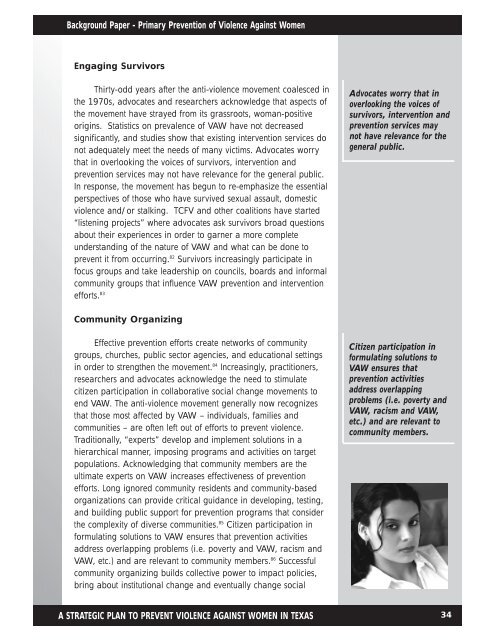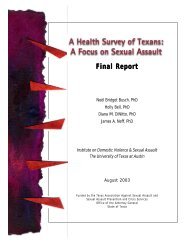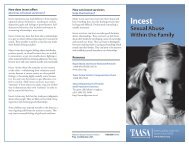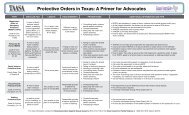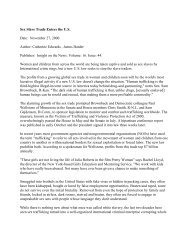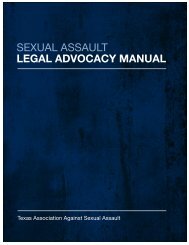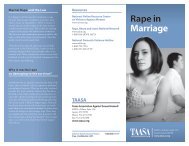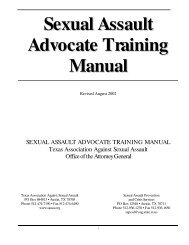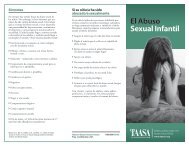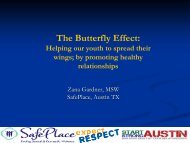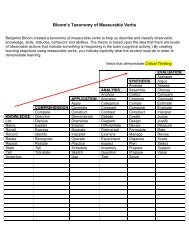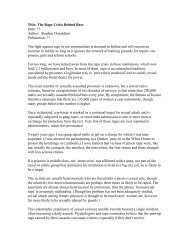TDH Booklet4 - Texas Association Against Sexual Assault
TDH Booklet4 - Texas Association Against Sexual Assault
TDH Booklet4 - Texas Association Against Sexual Assault
You also want an ePaper? Increase the reach of your titles
YUMPU automatically turns print PDFs into web optimized ePapers that Google loves.
Background Paper - Primary Prevention of Violence <strong>Against</strong> Women<br />
Engaging Survivors<br />
Thirty-odd years after the anti-violence movement coalesced in<br />
the 1970s, advocates and researchers acknowledge that aspects of<br />
the movement have strayed from its grassroots, woman-positive<br />
origins. Statistics on prevalence of VAW have not decreased<br />
significantly, and studies show that existing intervention services do<br />
not adequately meet the needs of many victims. Advocates worry<br />
that in overlooking the voices of survivors, intervention and<br />
prevention services may not have relevance for the general public.<br />
In response, the movement has begun to re-emphasize the essential<br />
perspectives of those who have survived sexual assault, domestic<br />
violence and/or stalking. TCFV and other coalitions have started<br />
“listening projects” where advocates ask survivors broad questions<br />
about their experiences in order to garner a more complete<br />
understanding of the nature of VAW and what can be done to<br />
prevent it from occurring. 82 Survivors increasingly participate in<br />
focus groups and take leadership on councils, boards and informal<br />
community groups that influence VAW prevention and intervention<br />
efforts. 83<br />
Advocates worry that in<br />
overlooking the voices of<br />
survivors, intervention and<br />
prevention services may<br />
not have relevance for the<br />
general public.<br />
Community Organizing<br />
Effective prevention efforts create networks of community<br />
groups, churches, public sector agencies, and educational settings<br />
in order to strengthen the movement. 84 Increasingly, practitioners,<br />
researchers and advocates acknowledge the need to stimulate<br />
citizen participation in collaborative social change movements to<br />
end VAW. The anti-violence movement generally now recognizes<br />
that those most affected by VAW – individuals, families and<br />
communities – are often left out of efforts to prevent violence.<br />
Traditionally, “experts” develop and implement solutions in a<br />
hierarchical manner, imposing programs and activities on target<br />
populations. Acknowledging that community members are the<br />
ultimate experts on VAW increases effectiveness of prevention<br />
efforts. Long ignored community residents and community-based<br />
organizations can provide critical guidance in developing, testing,<br />
and building public support for prevention programs that consider<br />
the complexity of diverse communities. 85 Citizen participation in<br />
formulating solutions to VAW ensures that prevention activities<br />
address overlapping problems (i.e. poverty and VAW, racism and<br />
VAW, etc.) and are relevant to community members. 86 Successful<br />
community organizing builds collective power to impact policies,<br />
bring about institutional change and eventually change social<br />
Citizen participation in<br />
formulating solutions to<br />
VAW ensures that<br />
prevention activities<br />
address overlapping<br />
problems (i.e. poverty and<br />
VAW, racism and VAW,<br />
etc.) and are relevant to<br />
community members.<br />
A STRATEGIC PLAN TO PREVENT VIOLENCE AGAINST WOMEN IN TEXAS<br />
34


